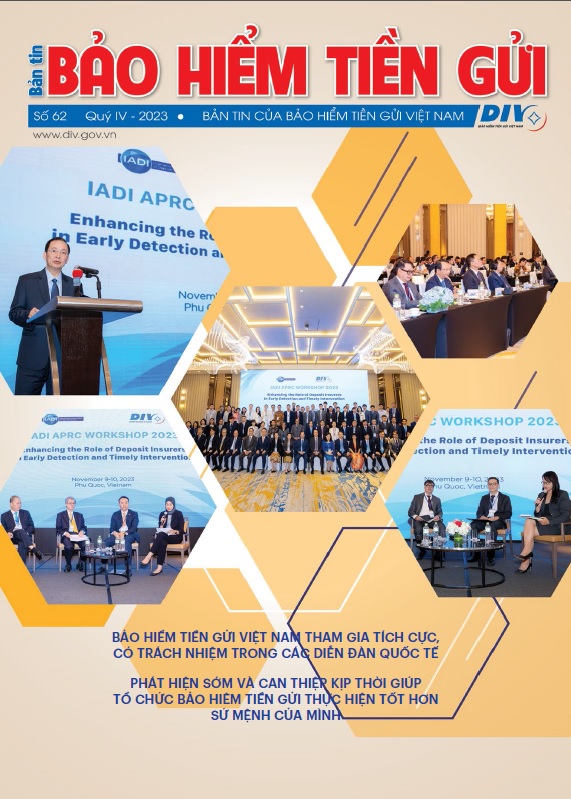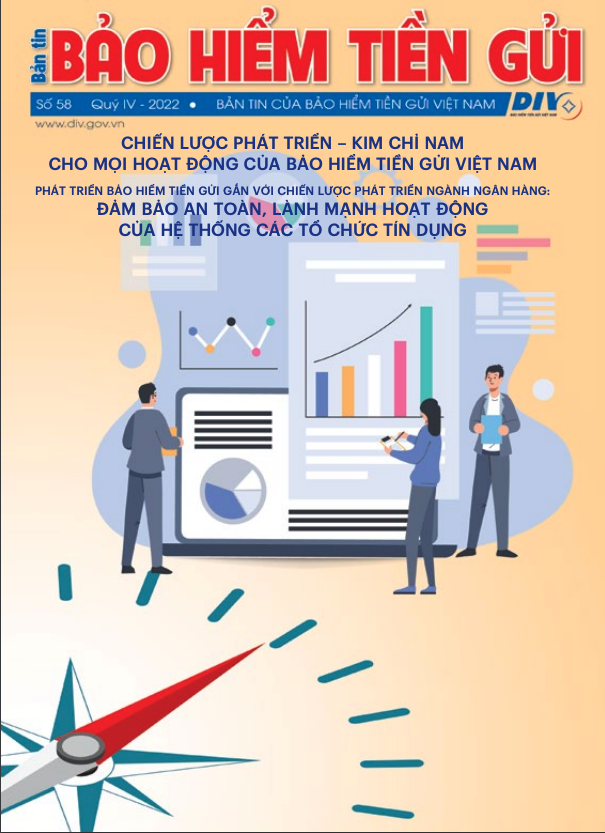Recently, the police have warned about the situation of some individuals setting up websites, using social networks, impersonating bank and post office employees, and using tricks to entice people to deposit at high interest rates. Initially, they pay regular interest but not return the principal. After a while, they take down websites or cut off communications and then flee.
For poor people in remote and rural areas, the majority of them have small savings. If they do not know about insured institutions, they are easily seduced and manipulated by fraud through which they would be seduced and enticed to deposit without ensuring the safety of the deposit.
Ensure the legal rights of depositors at microfinance institutions
Conceptually, microfinance is a type of financial service provision for individuals, low-income households, and micro-enterprises. Along with commercial banks, technology companies, mobile network and communications providers, microfinance has become an important part of the effort to promote financial inclusion in Vietnam.
The activities of microfinance institutions are regulated in the Law on credit institutions 2010 and Article 32 of Circular No.03/2018/TT-NHNN, specifically as follows:
Regarding capital mobilization of microfinance institutions: According to Article No.119 of the Law on Credit Institutions 2010 and Clause 2, Article 32 of Circular No. 03/2018/TT-NHNN: (i) Receiving deposits in Vietnamese Dong in the following forms: Compulsory savings according to regulations of microfinance institutions; deposits from organizational and individual include voluntary deposits of microfinance customers, except for deposits for payment purposes; borrow capital from credit institutions, financial institutions, and other domestic and foreign individuals and organizations according to the provisions of the law.
Regarding credit granting activities of microfinance institutions: Article No.120 of the Law on credit institutions 2010 and Clauses 3, 4 and 5, Article 32 of Circula No.03/2018/TT-NHNN stipulate: (i) microfinance institutions are only allowed to currently lends loans in Vietnamese Dong to microfinance and other customers for use in income-generating activities and improving living conditions. Loans from microfinance institutions can be secured by compulsory savings, guarantees from savings and loan customer groups according to the regulations of the microfinance institution; (ii) Microfinance institutions must maintain a minimum ratio of 90% of total outstanding loans to microfinance customers; (iii) The total loan balance of a microfinance institution to a microfinance customer must not exceed 50 million VND. The microfinance institution's total loan balance to another customer must not exceed 100 million VND.
The Law on deposit insurance and Decree No.68/2013/ND-CP dated June 28, 2013 detailing and guiding the implementation of the Law on deposit insurance stipulate and guide in detail: "Microfinance institutions must participate in deposit insurance for individual deposits, including voluntary deposits of microfinance customers, except for mandatory savings according to regulations of microfinance institutions.”
Thus, in addition to commercial banks, foreign bank branches, cooperative banks, and people's credit funds, people can completely be secured when depositing money at microfinance institutions because it is both safe and insured. Similar to other credit institutions, the legal rights and interests of depositors at microfinance institutions are always guaranteed. This is also a premise to promote competitive advantage in providing convenient savings services to mobilize and expand the scale of capital for microfinance institutions.
Customers who voluntary deposit at microfinance institutions are guaranteed safety, because the Law on deposit insurance in Vietnam stipulates that deposit insurance is guarantee for the depositors within deposit insurance coverage limit when an insured institution become insolvent or bankrupt.
In addition, when depositing at microfinance institutions, customers have absolute information security. With the motto of taking customer benefits as a business philosophy, the organization's information management system ensures security and its information technology staff is trained to protect the security, confidentiality, accuracy, and integrity of personal information as well as such as customer finance.
In fact, the savings products of microfinance institutions meet the needs of customers and affirm the prestige and trust of microfinance institutions to their members. The advantage of microfinance is mutual support and assistance among low-income members in the form of unsecured loans through guarantees from groups of borrowers (5 to 7 people or more). So when a customer in the group has difficulty paying their due debt, the remaining members will help repay the debt. Flexible principal and interest payment methods weekly, bi-weekly, monthly or quarterly in accordance with the purpose of each loan and the production and business cycle. Thanks to that, the bad debt ratio of microfinance institutions is low, business results are quite high with income greater than expenses.
In Vietnam, there are only 4 official microfinance institutions that have been granted establishment and operation licenses by the State Bank of Vietnam according to the provisions of the Law on credit institutions, including: Tinh Thuong one -member limited liability microfinance organization (TYM), two or more members microfinance limited liability institution M7 (MF – MFI), Thanh Hoa microfinance limited liability institution (Thanh Hoa MFI) and one-member limited liability microfinance institution for poor self-employment workers (CEP). In addition, there are other credit institutions that provide microfinance services in Vietnam, such as the Bank for Social Policies and the people's credit fund system.
Recently, microfinance institutions in Vietnam have attracted a large number of customers who regularly deposit savings. Recognizing the importance of deposit insurance to banking activities, microfinance institutions have seriously implemented their participation in deposit insurance and have been granted a certificate of participation in deposit insurance participation by Deposit Insurance of Vietnam (DIV). Thereby, it aims to protect the legal rights of customers who deposit voluntary savings, contributing to stabilizing the operations of microfinance institutions.
It can be said that microfinance provides opportunities for people in rural areas - especially the poor - to access financial services and increase participation in the community. Because it is easy to see that microfinance institutions can directly access customers, from disbursing capital to recovering capital in regions and areas that banks or traditional branch models cannot reach. In addition, microfinance also empowers women by increasing their ability to collect and control assets, helping them to be autonomous and make major decisions in the family; Increase income for poor - near-poor households by covering medical and educational costs, improving health and nutrition...
Improve customers’ knowledge about deposit insurance at microfinance institutions
In Vietnam, DIV is the State financial institution implementing deposit insurance policy. The outstanding role of deposit insurance is to promote and improve the quality of banking operations, aiming to attract maximum temporarily idle capital in the social community, based on mutual benefit. For depositors, DIV's activities contribute to strengthening public trust in the banking system and protecting the legal rights of depositors. For the banking system, deposit insurance contributes to creating favorable conditions for the banking system to develop healthily and safely and promote deposit mobilization for development investment. Thereby, creating conditions to promote sustainable development of the country's economy.
Regarding the deposit insurance organization, in recent times, DIV always focuses on implementing deposit insurance policy at the group of microfinance institutions in synchronization with other types of insured organizations, although the number of microfinance organizations is currently is still modest. The implementation of deposit insurance policies at microfinance institutions is timely and complete through a series of professional activities such as: granting and re-issuing certificates of participation in deposit insurance; on-site examination, off-site supervision and policy communication on deposit insurance...
Specifically, regarding on-site examination and off-site supervision, DIV always strives to ensure synchronization and consistency according to DIV's examination regulations, contributing to detecting shortcomings and limitations in administration and examination, internal control, capital mobilization, credit activities, accounting, cash receipts and payments, management of documents... as well as the level of serious implementation of the Law on deposit insurance. DIV is ready to support microfinance institutions in clearly identifying the cause and recommending remedial measures.
Besides, DIV identified policy communication of deposit insurance as one of the important operations that need to be promoted at microfinance institutions. From there, raise the awareness of microfinance institutions themselves about deposit insurance policies, increase awareness of voluntarily complying with regulations and instructions of DIV, contributing to stabilizing the operation of the national financial and banking system.
Besides, in recent times, the legal environment for microfinance activities in Vietnam has also been continuously improved to create conditions for microfinance to develop, thereby promoting financial inclusion and contributing to poverty reduction and preventing black credit.
However, in reality, microfinance institutions operations are still fragmented, products and services are not diverse, and operational and sustainable development indicators are not high. In general, the operations of microfinance institutions face many difficulties when simultaneously pursuing financial and social goals. Balancing both goals needs to aim at professionalizing operations, creating friendly and accessible financial services for the poor right in the community, contributing to reducing loan sharking and protecting human rights. benefit of depositors.
It can be said that the social effectiveness of a microfinance institution is the positive impact on financial service users, employees at that organization, the surrounding community and the environment that microfinance activities bring about, demonstrate social responsibility and sustainability are always evaluated along with accessibility and safety.
Especially, in rural and remote areas, there are still depositors at microfinance institutions who do not understand the deposit insurance policy, so they are still feel hesitant. Some microfinance institutions have not fully implemented deposit insurance policies, so they are somewhat limited in encouraging people to deposit money at these organizations. The implementation of deposit insurance policies at microfinance institutions still has many shortcomings such as: some microfinance institutions have not submitted applications to participate in deposit insurance on time; not providing enough reporting information according to the SBV's regulations on reporting information regime; there are still errors in complying with legal regulations on deposit insurance. The main reason comes from the fact that microfinance institutions still do not have a comprehensive and complete grasp of the provisions of law on deposit insurance.
Therefore, in the coming time, DIV needs to continue to coordinate with microfinance institutions and media agencies to promote communication aimed at poor people, disadvantaged people, people in rural and remote areas to improve knowledge of microfinance, thereby improving people's access to finance, helping them stay away from black credit... At the same time, promote the implementation of deposit insurance policies at microfinance institutions through many forms, including communication work to spread out deposit insurance policies to people in rural and remote areas; strengthen connections between central agencies and DIV with microfinance institutions to spread policies, thereby strengthening depositors' confidence, increasing capital sources for microfinance institutions, and synchronously combine other policies so that microfinance organizations have conditions for safe, healthy and effective development.
Communication Department



























